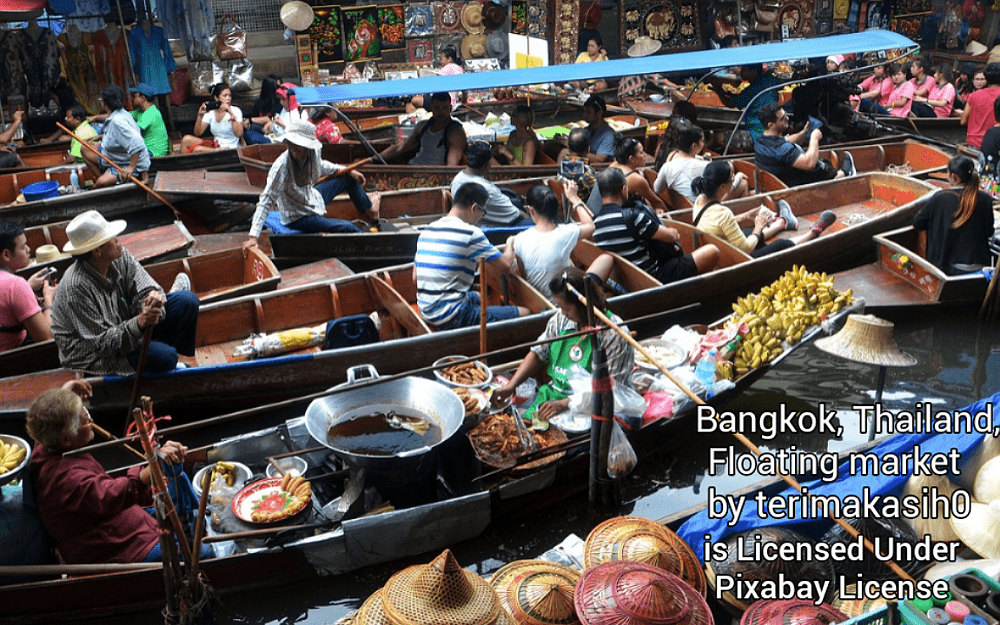Jitsiree Thongnoi

Saichon Chounchou, a Thai tour guide who speaks Mandarin, has been serving visitors from mainland China for the past 26 years, but lately a majority of his tourist clients have been arriving from elsewhere.
Thailand’s tourism industry has not been attracting nearly as many visitors from China as hoped for after the Chinese government removed pandemic-related restrictions for outbound travelers in early 2023, and the new Thai government waived visa requirements for Chinese visitors.
Instead, large numbers of tourists have been arriving from Taiwan, India and other places. The new trend has had a positive effect in terms of spending, said Saichon, 48.
“Now my clients are Taiwanese,” he said. “They are regular clients, and they generate revenue for many local communities as opposed to many Chinese on a ‘zero-dollar’ tour,” he told BenarNews.
Zero-dollar tourism has run rampant in Thailand for years and refers to tour companies from China taking visitors only to Chinese-run restaurants, spas or stores, cutting potential revenues to local businesses, Saichon said.
By comparison, his 20-person group of Taiwanese tourists “will stay in a 5-star hotel for five days and the package is 100,000 baht (U.S. $2,793) per person.”
According to government data, about 585,000 Taiwanese have visited Thailand in the first 10 months of 2023. Saichon expected those numbers to go up as a result of a new visa-free policy for visitors from Taiwan implemented in early November.
More than a year after Thailand lifted all Covid-19 restrictions in the second half of 2022, tourism, a key driver of the Thai economy that contributed to around 11% of the GDP in 2019, is picking up more slowly than expected.
Bangkok aims to receive as many as 28 million international visitors this year compared to a record 40 million visitors in 2019. That year, more than one-quarter of the international visitors – about 11 million – were from China.

Between January and Dec. 3 this year, Thailand welcomed over 25 million visitors. Among them were 4 million from Malaysia, 3.1 million from China, 1.4 million from South Korea, 1.4 million from India and 1.2 million from Russia.
Before leaving office earlier this year, former Prime Minister Prayuth Chan-o-cha projected that as many as 30 million tourists would visit in 2023.
Political efforts
Within weeks of taking office in September, the new Thai government under Prime Minister Srettha Thavisin issued a visa-free entry for Chinese nationals effective through Feb. 29, 2024. During his recent visit to Beijing for the Belt and Road Forum for International Cooperation, Srettha proposed that the measure could be permanent.
Srettha’s effort to allow visa-free travel has not been as effective as officials had hoped: Thailand likely will miss its target of 4 million to 4.4 million Chinese arrivals in 2023. The Tourism Authority of Thailand this month revised the target to 3.5 million Chinese by Dec. 31.
“Chinese tourists are concerned about safety in Thailand, and the Thai government just can’t crack the code of why Chinese have not come as much as before,” Saichon, the tour guide, said.
Chada Triamvithaya, a Chinese studies academic at Thailand’s King Mongkut’s Institute of Technology Ladkrabang, said that while China’s economic performance has been a factor affecting outbound tourism, concerns about the risk of being kidnapped play a part.
China’s GDP outlook for 2023 was 5% earlier this year, the lowest in decades, as it struggles to recover after years of Covid restrictions and following the sharp rise of youth unemployment in recent months.
A March editorial in Chinese state-run news outlet The Global Times addressed concerns on social media about Chinese tourists’ safety in Thailand.
It also noted that “Chinese tourists complained about greater price increases, being cheated and worse service experiences than before.
“Negative information about traveling to Thailand such as ‘Is it still safe to travel to Thailand?’ and ‘Thailand is not the same as it used to be’ recently received constant attention on the Chinese internet … ‘trafficking of women’ and ‘removal of kidney’ have been particularly prominent in the past few days.”
The piece notes that while these rumors have been refuted, “we hope that Thailand will live up to its reputation and not disappoint the expectations of Chinese tourists.”
Thai officials are working on public relations to restore faith in the nation as a tourism destination.
Just last month, Puangpet Chunlaiad, the Prime Minister’s Office minister, met with Han Zhiqiang, the Chinese ambassador to Thailand, to discuss “No More Bets,” a Chinese crime film about a couple lured to work overseas who end up in a fraud factory.
The film depicts an unnamed country similar to Thailand, which led to some negative comments on Weibo, a Chinese social media platform.
But real incidents also caused a crisis of confidence among the Chinese. In mid-October, Chinese arrivals at Thai airports fell by 60,000 in the week following the Oct. 3 shooting at Siam Paragon Mall, which killed three, including a Chinese citizen.
In the northern city of Chiang Mai, the falling number of Chinese tourists is hitting hard.
“Chiang Mai used to receive tourists on direct flights from China numbering 2,000 to 3,000 on a daily basis,” said La-Iad Bungsrithong, an executive of RatiLanna Riverside Spa Resort in Chiang Mai.
“But that was between 2015 and 2019. Now, only 500 to 600 Chinese tourists arrive in Chiang Mai daily.”
Recovery challenges
Analysts are hesitant to project if and when the nation’s tourism can rebound to pre-Covid-19 levels, if at all.
“Absolutely, this is the start of a new cycle and Thailand remains a favored global destination. The world remains a volatile place politically and economically and tourism is not different,” Bill Barnett, managing director of the Phuket-based hospitality consultancy C9 Hotelworks, told BenarNews.

Even as the Thai tourism sector considers a future with or without Chinese visitors, it is eager to welcome tourists from India along with Taiwan, who recently became the latest group to receive visa waivers effective through May 2024.
“If the free visas didn’t work for the Chinese, it worked for the Indians,” said Patcharee Iamrod, a Pattaya-based tour guide who for 15 years has specialized in the Indian market. “After the free visa was issued, the number spiked.”
In 2019, before the Covid shutdown, nearly 2 million Indians visited Thailand – an increase of about 25% over the previous year – the biggest increase among nations sending visitors to Thailand.
“I receive about three to five Indian tour groups a month. They usually book a three-country tour of Singapore, Malaysia and Thailand for about 10 to 12 days. Affordable tickets to Thailand and the convenience now with the free-visa regulation have helped them make faster decisions to come here,” Patcharee said.
But she said cost-related factors have hindered the recovery of the tourism industry.
“It seems tourists need a higher budget to travel in Thailand post-Covid,” she said.
“This is because of higher costs. Some hotels were renovated during Covid and have reopened, but with limited staff, they can receive a limited number of guests, so the rate per night is higher.”
Patcharee said she didn’t think that Thailand would ever see the number of Chinese at pre-Covid levels again “since we have seen the crackdown on the zero-dollar tourism in Thailand and independent travelers from China have not made their way back that much.”
Chada, the academic, meanwhile, said effective communication could help win back some of the visitors but would require “both people and the media to help communicate to the Chinese.”
Copyright ©2015-2022, BenarNews. Used with the permission of BenarNews.














